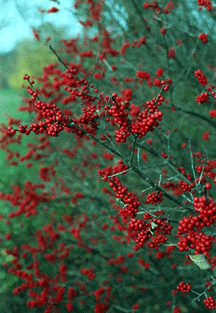
|
Volume XVII, Issue 9 - February 26 - March 4, 2009
|
|
Columns Reviews |

Colorful Relief from Winter’s Gray
Winterberry drops its leaves in the fall but produces an abundance of red berries

![]() Those bright red-berried shrubs you see in neighbors’ yards (including mine) and being planted along highways are mostly winterberry, a deciduous holly.
Those bright red-berried shrubs you see in neighbors’ yards (including mine) and being planted along highways are mostly winterberry, a deciduous holly.
You probably recognize American holly, with its red berries and evergreen leaves. But you may not recognize deciduous hollies. First, their leaves are very different in shape than those of American hollies. Second, the leaves drop in the fall.
Like most hollies, deciduous hollies require both male and female plants to produce an abundance of bright red berries. You need one male holly, planted within 50 feet, for every eight to 10 female plants. Flies do the pollination.
Plant in full sun to maximize fruit production. Winterberry grows naturally in boggy areas throughout most of Maryland. But it will also grow in well-drained soils.
If you’re committed to natives, consider planting Maryland Beauty deciduous holly. Maryland Beauty is a botanical form that was found growing in a bog in Mitchellville, in Prince George’s County. Its berries are bright red and nearly twice as large as most winterberry hollies’. The Bay Gardener was involved in its selection and in developing methods of propagation.
If you want your plant to produce an abundance of large bright red berries, make certain that you also purchase a male deciduous holly
Pine Needles on Grass
Q My yard is half fescue sod, laid last year, and half old loblolly pines. The contractor was adamant that I needed to keep the pine needles cleaned off the sod. Which I did diligently last year by raking prior to mowing/mulching when the needles were heavy. Being an old guy, I would like to minimize both the raking and the bagging. How concerned should I be about the needles on the grass as long as they are not thick enough to shade the grass?
–Paul Schaeffer, Tilghman Island
A A light sprinkling of pine needles will provide partial shade so that the soil will not dry out. It will not increase the acidity of the soil. A heavy application of pine needles, sufficient to block sunlight from reaching the new grass, will cause problems of shading and a slight change in pH.
Cut your grass tall and let it fall to allow both the grass clippings and the pine needles to compost in place. Forget about raking and bagging.